Erin Morgan Experiences the Beauty, Fragility of Antarctica
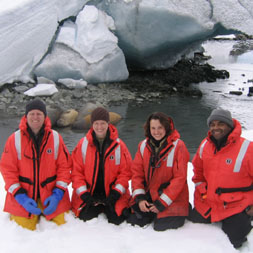
My passion for the marine environment and its conservation was central to my decision to pursue a degree in Biology and Environmental Science at William and Mary.
As an undergraduate, I had the opportunity to work as a research assistant both on campus and abroad. I began my first year doing local environmental work as a student in the Sharpe Scholars program, and later assisted with research in the W&M Geology Dept. and at VIMS, completed an REU summer internship in Alabama, studied aboard a tall ship during a SEA semester, and worked as an environmental educator. My experiences helped me to learn about the process of doing research, introduced me to supportive professors and mentors, and continually provided me with further opportunities to expand my knowledge of biology, ecology, and field work.
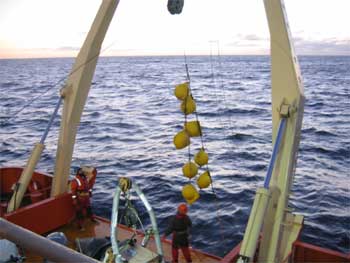
My undergraduate research experiences were both fulfilling and rewarding--so when a friend told me about his work as a laboratory technician aboard the Antarctic research vessel R/V Laurence M. Gould, I was immediately interested in having a similar experience. I applied for the same "lab tech" position and was thrilled when I heard, months later, that I had been selected to participate in the 2008 research cruise!
Our month-long research cruise was part of the Long Term Ecological
Research (LTER) project based out of Palmer Station, on the West
Antarctic Peninsula. Funded by the National Science Foundation, the
goal of the LTER program is to investigate the changing ecosystem of
the upper water column near the peninsula; each year, the Gould
travels from Anvers Island to points below the Antarctic Circle,
sampling transects both inshore and offshore to facilitate this
research. Scientists study ecosystem components such as light and sea
ice as well as microbial communities, plankton, and seabirds.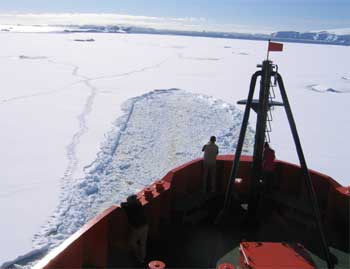
In January, our ship left from Punta Arenas, Chile, crossed the infamous Drake Passage, and stopped at Palmer Station before beginning to collect samples. I was hired as a lab tech in the Microbial Biogeochemistry lab, under the direction of Dr. Hugh Ducklow. The goal of our research was to study the "microbial loop"--how water column bacteria cycle nutrients (such as carbon) in the ecosystem.
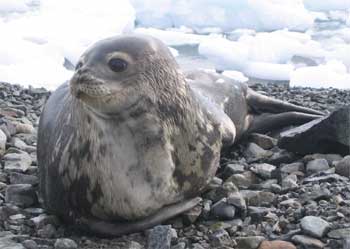 We spent our shifts collecting and analyzing data from water samples
(some taken from depths of over 12,000 ft!) and running experiments in
our ship-board lab. In addition, I learned about the ship itself from
the crew, and the research occurring in other labs from their
scientists and techs. We saw incredible icebergs, broke through sheets
of ice that stretched across narrow channels, and were stalked by
leopard seals in our Zodiac. We crossed the Antarctic Circle with
proper fanfare and deference to King Neptune. I saw the sun both set
and rise within 3 hours, and experienced four weeks without true
darkness. We met British scientists and "birders," Minke whales and
Humpbacks, and tens of thousands of penguins. I had the privilege of
working with and learning from an amazingly talented group of
scientists, enjoying the Gould's rich shipboard community, and seeing a truly breathtaking and incomparable continent.
We spent our shifts collecting and analyzing data from water samples
(some taken from depths of over 12,000 ft!) and running experiments in
our ship-board lab. In addition, I learned about the ship itself from
the crew, and the research occurring in other labs from their
scientists and techs. We saw incredible icebergs, broke through sheets
of ice that stretched across narrow channels, and were stalked by
leopard seals in our Zodiac. We crossed the Antarctic Circle with
proper fanfare and deference to King Neptune. I saw the sun both set
and rise within 3 hours, and experienced four weeks without true
darkness. We met British scientists and "birders," Minke whales and
Humpbacks, and tens of thousands of penguins. I had the privilege of
working with and learning from an amazingly talented group of
scientists, enjoying the Gould's rich shipboard community, and seeing a truly breathtaking and incomparable continent.
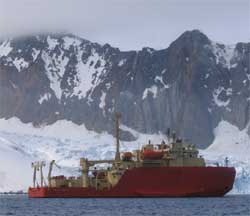 Experiencing the beauty of the Antarctic and recognizing its fragility
has made me even more determined to use my career to link science with
policies that promote responsibility, sustainability, and conservation.
Currently, I am working as a laboratory technician in the Wetlands
Ecology lab at VIMS and looking ahead to working as an environmental
educator aboard the tall ship Adventuress
this summer. I plan to apply to interdisciplinary doctoral programs
that focus on marine biology and environmental issues, and to begin
working toward my degree in Fall 2009.
Experiencing the beauty of the Antarctic and recognizing its fragility
has made me even more determined to use my career to link science with
policies that promote responsibility, sustainability, and conservation.
Currently, I am working as a laboratory technician in the Wetlands
Ecology lab at VIMS and looking ahead to working as an environmental
educator aboard the tall ship Adventuress
this summer. I plan to apply to interdisciplinary doctoral programs
that focus on marine biology and environmental issues, and to begin
working toward my degree in Fall 2009.














